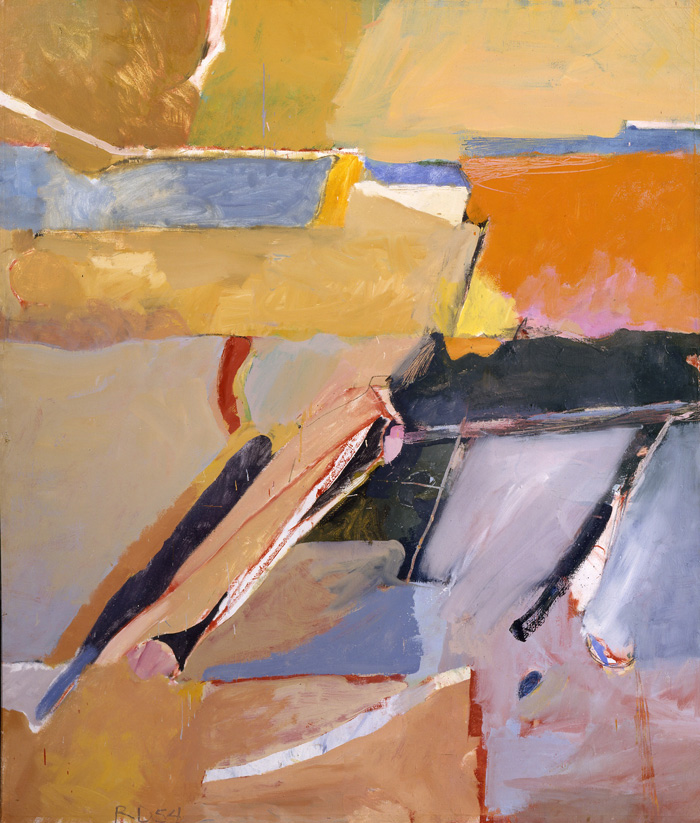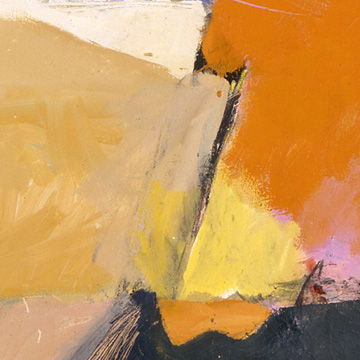
Berkeley No. 8
Richard Diebenkorn, American, 1954
(oil on canvas)
North Carolina Museum of Art, Raleigh
Let’s focus on what an artist put in—not what he left out.
What is art? At one time, only art that looked real and had a lot of details was valued. Even today, many people think art should be an exact copy of a subject. Let’s pretend you have an adorable new puppy and you ask an artist to paint him. Perhaps you want the painting to look just like your puppy. Perhaps you want the artist to show every detail—from your puppy’s fluffy tail to his bright eyes and floppy ears. Perhaps you think that if the artist is able to paint a true-to-life description of your puppy, it shows he or she is talented. However, art can have a lot of details, it can have a few details, or it can have hardly any details at all. Artists who make art with few details can be just as talented as artists who make art with many details. Artists make art in different ways and in different styles, in part because their environment and time make their work different from the work of other artists in other cultures, times and places. In my blog entries, I show you many different styles of art from many different times and places.
What about the artist who painted this picture? Did he leave out many of the details? He did. When an artist removes the details from a work of art, it is abstract. Instead of focusing on what the artist left out, let’s focus on what the artist put in. He put in many colors and shapes, didn’t he? Do the colors and shapes look like things you see in nature? Use your imagination. Let the colors and shapes form pictures in your mind. Describe what you see. Can you imagine fields, roads, waterfalls, rivers, ocean waves, sky, sand and clay? Use your language arts skills. Describe the colors and shapes. Are the colors bright or dull or both? Are the shapes perfectly geometric or are they a bit uneven? What kind of mood do the colors and shapes give the work? Is it peaceful, serene and calm, or vibrant, busy and energized? Let’s play a word game. Are the colors and shapes hot or cold? Heavy or light? Soft or hard? Rough or smooth? Happy or sad? Chaotic or orderly?

Close-up
Berkeley No. 8
Do you see movement in the composition? There is movement in the repetition of the blocks of color. There also are diagonal lines. Like the repeated blocks of color, diagonal lines create movement. Imagine a line down the center of the composition. Is this work symmetrical? Are both sides of the painting the same? No, this work has asymmetrical balance that creates a contrasting pattern. If this work were a piece of music, what instrument would play its tune? Would it be the strong throb of a drum, perhaps? The strumming strings of a guitar? The soothing breath of a flute? What rhythm would it have? Would it be staccato with a beat that changes suddenly or would the beat be constant? Would the music be sharp and uneven and very quick, or smooth and even and slow? What do you see in the painting that makes you say this?
If I were to tell you the artist who made this painting lived in the San Francisco Bay Area in northern California and in New Mexico in the southwest, would this change how you view this painting? How so? What body of water borders California? The Pacific Ocean borders California. Do you know what type of climate the San Francisco Bay Area has? It has mild summers and cool winters. Just north of San Francisco there is enough precipitation and the soil has many nutrients enabling farmers to grow crops such as grapes, from which they make wine. Describe the climate in the southwest. The climate is hot and dry during the summer and in some parts is cold during the winter. There isn’t a lot of precipitation and there is a lot of desert land. Do you know what type of crops are grown in New Mexico? Because the land is more arid in New Mexico, crops that require less water such as corn are grown there. In the southern part of New Mexico there are few trees, so buildings are made from adobe. What is adobe? Adobe is baked earth (sand, clay, water and straw) formed into blocks and plastered with mud.
Let’s look closely at this painting a moment longer. We learned that an artist’s environment helps to make his or her work look a certain way. The artist who painted this picture lived in California where there is a large body of water and in the southwest where the environment is desert land. Knowing this, how do the parts come together? What do you see? It may be just me, but I feel as if I am looking out of an airplane window at a wondrous landscape below. The blue colors look like an ocean, the yellow-and-orange-adobe hues look like patches of a desert, and the diagonal lines that cut into the horizontal lines look like roads cut into the earth. If you were to paint a landscape, would the environment where you live influence your work? What colors and shapes would you paint? Would your painting have a lot of details, a few details, or hardly any details at all?
§
Would you like to see Berkeley No. 8 in person? All you have to do is visit the North Carolina Museum of Art in Raleigh, North Carolina. Berkeley No. 8 is in the Modern galleries at the museum. Or perhaps you would like a tour. Tours of the collection are given daily, except for Monday when the museum is closed to the public. If you prefer, you can contact the museum ahead of time and arrange for you and your friends to have a private tour. I’m sure a docent at the museum would be happy to show you and your friends Berkeley No. 8 and many other works of art. Whether you visit the museum on your own or have a tour with a docent, it will be well worth your time!